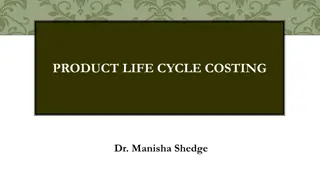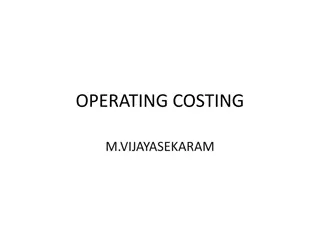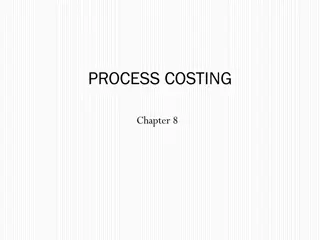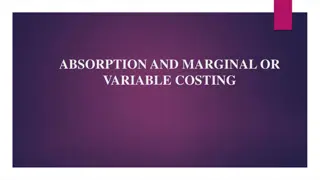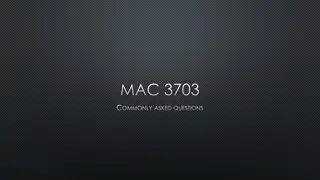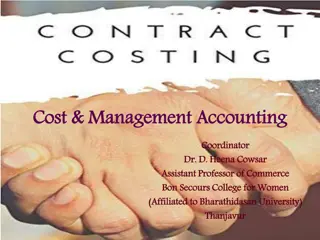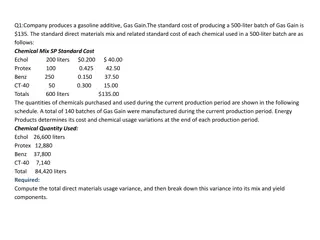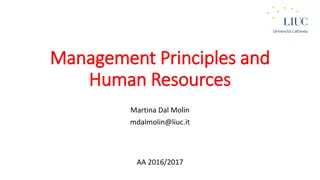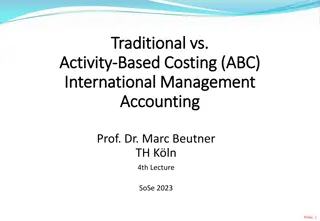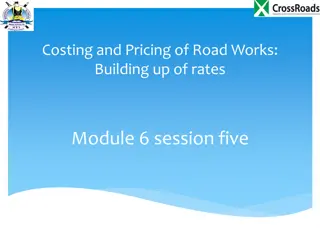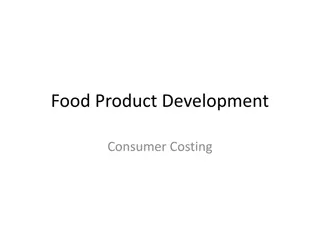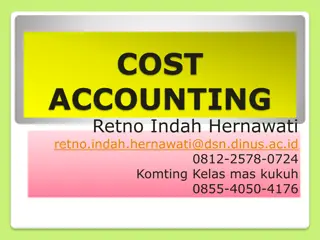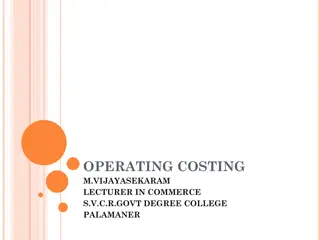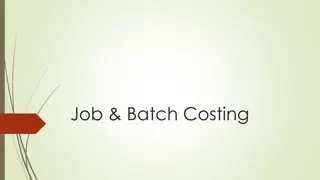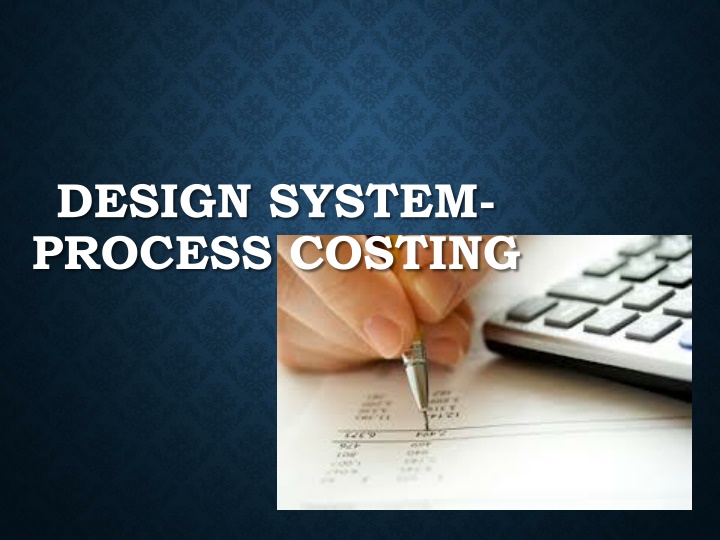
System Process Costing in Manufacturing Industry
Understanding the difference between job order costing and process costing in the manufacturing industry. Explore how these systems allocate costs to products and calculate unit costs, along with the key differences and considerations when implementing them.
Download Presentation

Please find below an Image/Link to download the presentation.
The content on the website is provided AS IS for your information and personal use only. It may not be sold, licensed, or shared on other websites without obtaining consent from the author. If you encounter any issues during the download, it is possible that the publisher has removed the file from their server.
You are allowed to download the files provided on this website for personal or commercial use, subject to the condition that they are used lawfully. All files are the property of their respective owners.
The content on the website is provided AS IS for your information and personal use only. It may not be sold, licensed, or shared on other websites without obtaining consent from the author.
E N D
Presentation Transcript
DESIGN SYSTEM- PROCESS COSTING
PERSAMAAN JOB ORDER DAN PROCESS COSTING Kedua sistem memiliki tujuan utama yang sama, yaitu membebankan biaya bahan baku, tenaga kerja dan overhead ke produk dan memberikan mekanisme perhitungan biaya per unit Kedua sistem menggunakan akun manufaktur dasar yang sama termasuk overhead pabrik, bahan baku, barang dalam proses dan barang jadi Aliran biaya melalui akun-akun manufaktur pada dasarnya sama untuk kedua sistem itu.
PERBEDAAN JOB ORDER DAN PROCESS COSTING Process costing digunakana pada saat seluruh unit produk identik dan diproduksi secara kontinu, sedangkan job order costing digunakan untuk jenis pekerjaan yang berbeda pada periode yang berbeda dan memiliki pesanan produksi yang berbeda pula Process costing mengakumulasi biaya per departemen, sedangkan job order costing menghitung biaya secara individual untuk masing-masing pekerjaan Dalam process costingt, laporan departemen produksi merupakan dokumen penting yang menunjukkan akumulasi biaya per departemen, sedangkan dalam job order costing kartu biaya merupakan dokumen pengendali biaya berdasarkan pekerjaan Dalam process costing, biaya perunit dihitung per departemen, sedangkan dalam job order costing biaya perunit dihitung berdasarkan pekerjaan
Quick Check Process costing digunakan untuk produk-produk yang: a. Berbeda dan diproduksi secara kontinu b. Sama dan diproduksi secara kontinu c. Diproduksi secara individualuntuk pelanggan tertentu d. Dibeli dari pemasok
Quick Check Process costing digunakan untuk produk-produk yang: a. Berbeda dan diproduksi secara kontinu b. Sama dan diproduksi secara kontinu c. Diproduksi secara individualuntuk pelanggan tertentu d. Dibeli dari pemasok
APA YANG DIMAKSUD DENGAN DEPARTEMEN PEMROSESAN (P.206) Lokasi yang berada dalam organisasi yang digunakan untuk menghasilkann produk dan menempatkan dan menambahkan bahan, tenaga kerja dan biaya overhead dalam suatu produk Aktivitas yang dilakukan di dalam departemen pemrosesan dilakukan seragam pada semua unit produksi, dan output dari departemen ini haruslah sama
PROSES BERURUTAN (SEQUENTIAL) DAN PROSES PARALEL Proses berurutan artinya unit-unit produksi mengalir secara berurutan dari satu departemen ke departemen yang lainnya Proses pararalel digunaka pada saat dimana pada satu titik, beberapa unit ditransfer ke departemen proses yang berbeda daripada yang lainnya. Contoh: Tempat penyulingan minyak bumi memisahkan Bahan bakar mentah ke dalam produk seperti minyak tanah, Bahan bakar pesawat dan bensin
COMPARING JOB-ORDER AND PROCESS COSTING Direct Materials Finished Goods Work in Process Direct Labor Manufacturin gOverhead Cost of Goods Sold
COMPARING JOB-ORDER AND PROCESS COSTING Costs are traced and applied to individual jobs in a job-order cost system. Direct Materials Finished Goods Direct Labor Jobs Manufacturin gOverhead Cost of Goods Sold
COMPARING JOB-ORDER AND PROCESS COSTING Costs are traced and applied to departments in a process cost system. Direct Materials Finished Goods Processing Department Direct Labor Manufacturin gOverhead Cost of Goods Sold
T-ACCOUNT AND JOURNAL ENTRY VIEWS OF COST FLOWS Diasumsikan bahwa terdapat dua departemen, yaitu departemen A dan Departemen B.
PROCESS COST FLOWS (IN T-ACCOUNT FORM) Work in Process Department A Direct Materials Raw Materials Direct Material s Work in Process Department B Direct Materials
PROCESS COST FLOWS (IN JOURNAL ENTRY FORM) GENERAL JOURNAL Page 4 Post. Ref. Date Description Debit Credit Work in Process - Department A XXXXX Work in Process - Department B XXXXX Raw Materials XXXXX To record the use of direct material.
PROCESS COST FLOWS (IN T-ACCOUNT FORM) Work in Process Department A Direct Materials Direct Labor Wages Payable Direct Labor Work in Process Department B Direct Materials Direct Labor
PROCESS COSTING (IN JOURNAL ENTRY FORM) GENERAL JOURNAL Page 4 Post. Ref. Date Description Work in Process - Department A Work in Process - Department B Salaries and Wages Payable To record direct labor costs. Debit XXXXX XXXXX Credit XXXXX
PROCESS COST FLOWS (IN T-ACCOUNT FORM) Work in Process Department A Direct Materials Manufacturing Overhead Direct Labor Overhead Applied to Work in Process Actual Overhea d Applied Overhead Work in Process Department B Direct Materials Direct Labor Applied Overhead
PROCESS COSTING (IN JOURNAL ENTRY FORM) GENERAL JOURNAL Page 4 Post. Ref. Date Description Work in Process - Department A Work in Process - Department B Manufacturing Overhead To apply overhead to departments. Debit XXXXX XXXXX Credit XXXXX
PROCESS COST FLOWS (IN T-ACCOUNT FORM) Work in Process Department B Work in Process Department A Direct Materials Direct Labor Applied Overhead Transferred to Dept. B Direct Materials Direct Labor Applied Overhead Transferred from Dept. A
PROCESS COSTING (IN JOURNAL ENTRY FORM) GENERAL JOURNAL Page 4 Post. Ref. Date Description Work in Process - Department B Work in Process - Department A To record the transfer of goods from Department A to Department B. Debit XXXXX Credit XXXXX
PROCESS COST FLOWS (IN T-ACCOUNT FORM) Work in Process Department B Finished Goods Direct Materials Direct Labor Applied Overhead Transferred from Dept. A Cost of Goods Manufacture d Cost of Goods Manufactured
PROCESS COSTING (IN JOURNAL ENTRY FORM) GENERAL JOURNAL Page 4 Post. Ref. Date Description Finished Goods Work in Process - Department B To record the completion of goods and their transfer from Department B to finished goods inventory. Debit XXXXX Credit XXXXX
PROCESS COST FLOWS (IN JOURNAL ENTRY FORM) Work in Process Department B Finished Goods Direct Materials Direct Labor Applied Overhead Transferred from Dept. A Cost of Goods Manufacture d Cost of Goods Manufactured Cost of Goods Sold Cost of Goods Sold Cost of Goods Sold
PROCESS COSTING (IN JOURNAL ENTRY FORM) GENERAL JOURNAL Page 4 Post. Ref. Date Description Accounts Receivable Sales To record sales on account. Debit XXXXX Credit XXXXX Cost of Goods Sold Finished Goods To record cost of goods sold. XXXXX XXXXX
UNIT EKUIVALEN PRODUKSI Unit ekuivalen merupakan produk yang telah diselesaikan sebagian yang terdiri dari persentase penyelesaian dariunit-unit tersebut. Diperlukannya untuk menghitung unit ekuivalen karena sebuah departemen biasanya mempunyai unit yang selesai sebagian (partially) di awal dan di akhir proses persediaan barang
PEMIKIRAN DASAR UNIT EKUIVALEN 2 unit produk yang selesai 1/2 equivalent dengan satu produk yang selesai. + = 1 Maka, 10,000 unit yang selesai 70% equivalent dengan 7,000 unit selesai
QUICK CHECK Untuk periode berjalan, Jones memulai produksi 15,000 unit and menyelesaikan 10,000 unit, WIP 5,000 unit 30% selesai. Berapakah unit ekuivalen produksi yang dimiliki Jones untuk periode tersebut? a. 10,000 b. 11,500 c. 13,500 d. 15,000
QUICK CHECK Untuk periode berjalan, Jones memulai produksi 15,000 unit and menyelesaikan 10,000 unit, WIP 5,000 unit 30% selesai. Berapakah unit ekuivalen produksi yang dimiliki Jones untuk periode tersebut? a. 10,000 b. 11,500 c. 13,500 d. 15,000 10,000 units + (5,000 units 0.30) = 11,500 equivalent units
MENGHITUNG EKUIVALEN UNIT Unit ekuivalen dapat dihitung dengan 2 cara: First-In, First-Out Method FIFO is covered in the appendix to this chapter. The Weighted-Average Method
UNTI PRODUKSI EKUIVALENWEIGHTED- AVERAGE METHOD Menggabungkan unit dan biaya dari periode sekarang dengan unit biaya periode sebelumnya Unit ekuivalen produksi untuk suatu departemen adalah jumlah unit yang ditransfer ke departemen berikutnya (atau barang jadi) + unit ekuivalen persediaan akhir barang dalam proses di departemen tersebut Unit Unit ekuivalen dalam persediaan akhir barang dalam proses Unit yang ditransfer ke departemen berikutnya atau barang jadi = Produksi Ekuivalen +
PROCESS COSTING AND DIRECT LABOR Direct Materials Direct labor costs may be small in comparison to other product costs in process cost systems. Dollar Amount Conversion Direct Labor Type of Product Cost
PROCESS COSTING AND DIRECT LABOR Direct Materials Direct labor costs may be small in comparison to other product costs in process cost systems. Conversion Dollar Amount Type of Product Cost Direct labor and manufacturing overhead may be combined into one product cost called conversion.
CONTOH WEIGHTED-AVERAGE Smith Company melaporkan aktivitas di Departemen A untuk bulan Juni sebagai berikut:: Percent Completed Units 300 Materials 40% Conversion 20% Work in process, June 1 Units started into production in June 6,000 Units completed and transferred out of Department A during June 5,400 Work in process, June 30 900 60% 30%
WEIGHTED-AVERAGE EXAMPLE Tahap 1: in calculating the equivalent units is to identify the units completed and transferred out of Department A in June (5,400 units) Materials Conversion Units completed and transferred out of Department A in June 5,400 5,400
WEIGHTED-AVERAGE EXAMPLE The second step is to identify the equivalent units of production in ending work in process with respect to materials for the month (540 units) and add this to the 5,400 units from step one. Materials Conversion Units completed and transferred out of Department A in June Work in process, June 30: 5,400 5,400 900 units 60% 540 Equivalent units of Production in Department A during June 5,940
WEIGHTED-AVERAGE EXAMPLE The third step is to identify the equivalent units of production in ending work in process with respect to conversion for the month (270 units) and add this to the 5,400 units from step one. Materials Conversion Units completed and transferred out of Department A in June Work in process, June 30: 5,400 5,400 900 units 60% 900 units 30% 540 270 Equivalent units of Production in Department A during June 5,940 5,670
WEIGHTED-AVERAGE EXAMPLE Equivalent units of production always equals: Units completed and transferred + Equivalent units remaining in work in process Materials Conversion Units completed and transferred out of Department A in June Work in process, June 30: 5,400 5,400 900 units 60% 900 units 30% 540 270 Equivalent units of Production in Department A during June 5,940 5,670
WEIGHTED-AVERAGE EXAMPLE Materials 6,000 Units Started Ending Beginning Work in Process 300 Units 40% Complete Work in Process 900 Units 60% Complete 5,100 Units Started and Completed 5,400 Units Completed 540 Equivalent Units 5,940 Equivalent units of production 900 60%
WEIGHTED-AVERAGE EXAMPLE Conversion 6,000 Units Started Ending Beginning Work in Process 300 Units 20% Complete Work in Process 900 Units 30% Complete 5,100 Units Started and Completed 5,400 Units Completed 270 Equivalent Units 5,670 Equivalent units of production 900 30%
PRODUCTION REPORT WEIGHTED-AVERAGE Production Report A quantity schedule showing the flow of units and the computation of equivalent units. Section 1 A computation of cost per equivalent unit. Section 2 Section 3
PRODUCTION REPORT Production Report Section 1 Section 2 Cost Reconciliation section shows the reconciliation of all cost flows into and out of the department during the period. Section 3
PRODUCTION REPORT EXAMPLE Diasumsikan Double Diamond Skis menggunakan metode rata-rata tertimbang dari proses costing untuk menentukan biaya perunit pada departemen pemotongan dan penggilingan
PRODUCTION REPORT EXAMPLE Barang dalam Proses, May 1: 200 unit Bahan Baku: 55% complete Konversi : 30% complete Produksi yang dimulai bulan May Produksi selesai bulan May $ 9,600 5,575 5,000 unit 4,800 units Biaya yang ditambahkan bulan May Biaya Bahan Baku Biaya Konversi Barang dalam Proses, May 31 unit Bahan Baku: 40% complete Konversi : 25% complete $ 368,600 350,900 400
PRODUCTION REPORT EXAMPLE Step1: Menyiapkan skedul kuantitas dan Menghitung Unit Ekuivalen. Unit yang diperhitungkan untuk: Barang dalam Proses, 1 May Masuk ke produksi Total units 200 5,000 5,200 Unit Ekuivalen Bahan Baku konversi Conversion unit produksi dihitung sbb: unit selesai dan dikirimkan Marangdalam proses 31 May 4,800 400 4,800 4,800
PRODUCTION REPORT EXAMPLE Step1: Prepare Quantity Schedule with Equivalent Units. Units to be accounted for: Work in process, May 1 Started into production Total units 200 5,000 5,200 Equivalent units Materials Conversion Units accounted for as follows: Completed and transferred Work in process, May 31 Materials 40% complete 4,800 400 4,800 4,800 160 5,200 4,960
PRODUCTION REPORT EXAMPLE Step1: Prepare Quantity Schedule with Equivalent Units. Units to be accounted for: Work in process, May 1 Started into production Total units 200 5,000 5,200 Equivalent units Materials Conversion Units accounted for as follows: Completed and transferred Work in process, May 31 Materials 40% complete Conversion 25% complete 4,800 400 4,800 4,800 160 100 5,200 4,960 4,900
STEP 2: CALCULATING THE COSTS PER EQUIVALENT UNIT To calculate the cost per equivalent unit for the period: Costs for the period Equivalent units of production for the period Cost per equivalent unit =
PRODUCTION REPORT EXAMPLE Step 2: Compute the cost per equivalent unit. Total Cost Materials Conversion Cost to be accounted for: Work in process, May 1 Costs added in the Shipping and Milling Department Total cost $ 15,175 $ 9,600 $ 5,575 719,500 734,675 $ 368,600 378,200 $ 350,900 356,475 $ Equivalent units Cost per equivalent unit 4,960 4,900
PRODUCTION REPORT EXAMPLE Step 2: Compute the cost per equivalent unit. Total Cost Materials Conversion Cost to be accounted for: Work in process, May 1 Costs added in the Shipping and Milling Department Total cost $ 15,175 $ 9,600 $ 5,575 719,500 734,675 $ 368,600 378,200 $ 350,900 356,475 $ Equivalent units Cost per equivalent unit $ 4,960 76.25 4,900 $378,200 4,960 units = $76.25
PRODUCTION REPORT EXAMPLE Step 2: Compute the cost per equivalent unit. Total Cost Materials Conversion Cost to be accounted for: Work in process, May 1 Costs added in the Shipping and Milling Department Total cost $ 15,175 $ 9,600 $ 5,575 719,500 734,675 $ 368,600 378,200 $ 350,900 356,475 $ Equivalent units Cost per equivalent unit Total cost per equivalent unit = $76.25 + $72.75 = $149.00 $ 4,960 76.25 $ 4,900 72.75 $356,475 4,900 units = $72.75
PRODUCTION REPORT EXAMPLE Step 3: Prepare a Cost Reconciliation Total Cost Equivalent Units Materials Conversion Cost accounted for as follows: Transferred out during May Work in process, May 31: Materials Conversion Total work in process, May 31 Total cost accounted for 4,800 4,800 160 100


